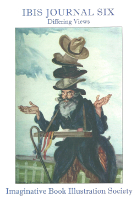
IBIS Journal 6: Differing Views

This Journal has articles on three fine illustrators whose entries can each be found under S in a dictionary of illustrators, but otherwise they have little in common.
Edmund Joseph Sullivan was a very well-read scholar and an exceptional draughtsman. He was a prolific illustrator and latterly a painter and print-maker. He thought deeply about his craft and taught both illustration and lithography at Goldsmiths College School of Art. He was one of that generation of artists who became illustrators just as photographic reproduction was replacing wood engraving, and was generally at his best in pen and ink. He excelled with projects that required him to visualise abstract concepts or to create visual metaphors to illuminate a text. He had a strong influence on Arthur Rackham, but unlike him rarely illustrated in colour, so his work has tended to be ignored both by collectors and galleries.
George Sheringham was highly regarded as a painter, muralist, designer of theatre sets and costumes for drama, ballet and D’Oyly Carte operas. He was a textile designer, poster artist, a painter of delectable fans, book illustrator, author, critic and inventor. He was an aesthete and a dandy, well connected in both art and social circles. In all of his artistic endeavours he was a pattern-maker and a sensitive colourist. His output as an illustrator was limited, but included two fine colour-plate books illustrated in his own distinctive variant of the art deco style. Bill Connolly gives us an insight into Sheringham's working life and into the production of these two volumes through his correspondence with John Lane, a friend and the publisher of one of those books.
William Small started his working life in the 1860s as a wood engraver with the publisher Nelson. He soon gained promotion to in-house illustrator. Having gained a firm grounding in both the craft and art of making illustrations via wood engraving, he set himself up as a freelance illustrator, establishing strong links with the Dalziels’ combining imaginative illustration with striking design, his art is both of its time and a challenge to its conventions. Simon Cooke argues that although appearance and the process of seeing are central to his effects, Small’s designs are a higher level of journalism which not only represents but comments on its subjects, and is sometimes nearer to satire than objective observation.
This journal brings together three outstanding artists who are currently relatively neglected. They worked at different times, in different media and different styles, but each had to live from their art and each gained distinction in their lifetimes.
Copies of Journal 6 may be purchased by members and non-members. Click on "How to Buy" in the menu on the left for more details.